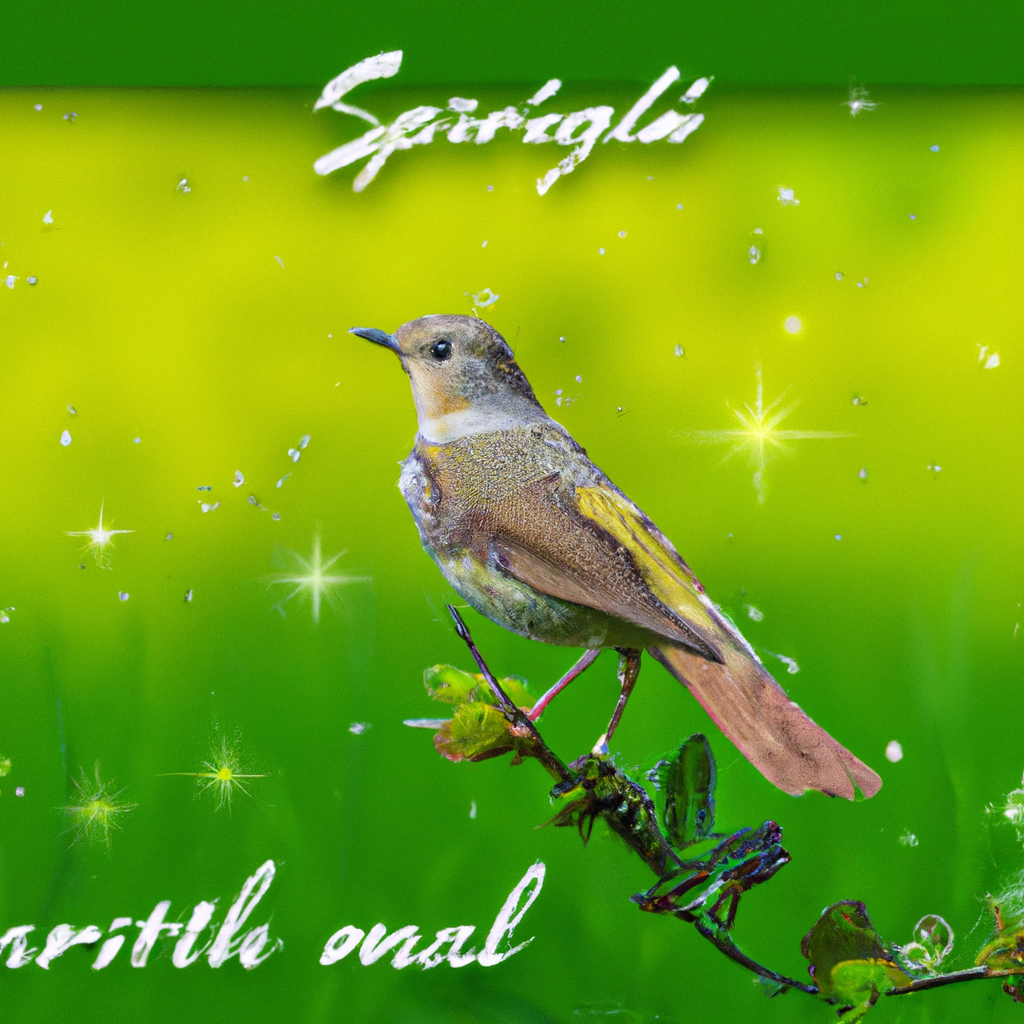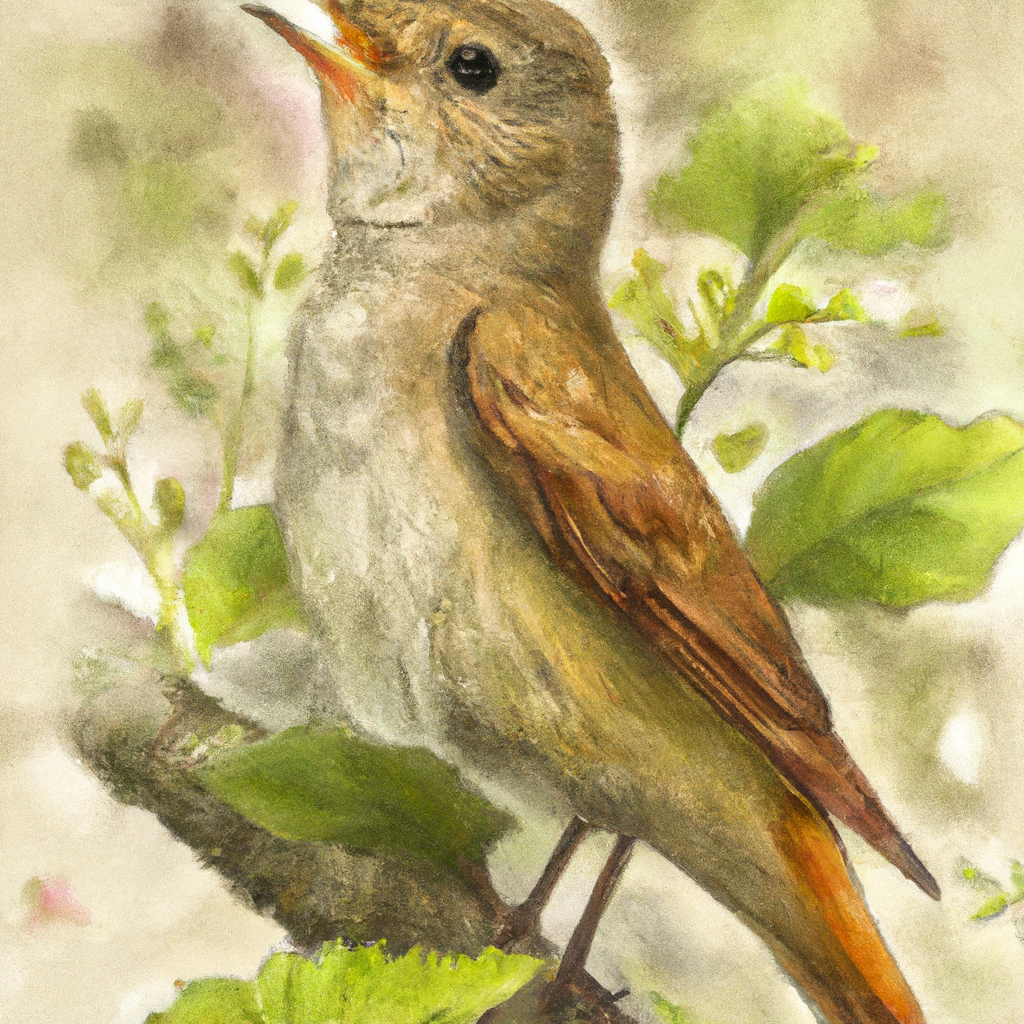The Nightingale (Luscinia Megarhynchos) is a small, unassuming passerine bird known for its remarkable song. This species, scientifically classified as Luscinia megarhynchos, is widely recognized for its melodious calls that fill the air during the breeding season. Found primarily in Europe and western Asia, the Nightingale has garnered significant attention from both ornithologists and nature enthusiasts due to its unique vocal abilities. Despite its relatively plain appearance, the Nightingale’s captivating song has earned it a place in countless cultural references throughout history.
Physical Description
Body size
The Nightingale is a small bird, measuring approximately 15 centimeters in length. It has a plump and rounded body, with a short tail and long wings that enable it to be an agile flyer. Despite its small size, the Nightingale possesses a powerful voice that carries over long distances.
Feathers
The Nightingale’s feathers are primarily brown, with shades ranging from a deep russet to a softer, more muted brown. Its plumage serves as effective camouflage, allowing it to blend seamlessly with the forest undergrowth where it resides. The feathers are soft and sleek, enabling the bird to move swiftly and quietly through vegetation.
Coloration
In addition to its predominantly brown feathers, the Nightingale displays subtle hints of reddish-brown on its chest and belly. Its throat is adorned with a pale, almost creamy coloring, and its eyes are a striking dark brown that adds depth to its overall appearance. These colorations allow the Nightingale to remain inconspicuous among the foliage while providing a subtle touch of beauty.
Habitat and Distribution
Natural habitats
The Nightingale is primarily found in dense deciduous forests, where it can take advantage of the abundant foliage for cover and nesting. It prefers areas with a mix of both thick undergrowth and mature trees, providing the perfect combination of shelter and foraging opportunities. However, this adaptable bird can also be found in scrublands and gardens, where it makes use of the available vegetation.
Geographical distribution
The Nightingale has a wide distribution across Europe and parts of Asia. It can be found throughout much of continental Europe, with populations ranging from the United Kingdom to Russia, and as far south as parts of North Africa. In Asia, it is found in countries such as Turkey and Iran. The bird’s range has expanded slightly in recent years, facilitated by its ability to adapt to various habitats.
Migration patterns
The Nightingale is a migratory bird, undertaking a remarkable journey each year. It spends the breeding season in Europe and Asia, but when the winter approaches, it embarks on a long migration to warmer regions in Africa and the Middle East. The exact migration routes may vary between individuals, but these journeys often cover thousands of kilometers. The Nightingale’s migration is a truly awe-inspiring feat of endurance and navigation.
Vocalizations
Melody of songs
The Nightingale’s song is considered one of the most beautiful and melodious in the bird kingdom. It is a complex and varied composition, featuring a rich tapestry of notes and trills. The song is characterized by its lyrical quality, with a flowing cadence that captivates the listener. The Nightingale’s voice possesses an ethereal quality, evoking a sense of tranquility and connection with nature.
Purpose of singing
The male Nightingale sings primarily to attract a mate and establish its territory. Its powerful song resonates throughout its habitat, serving as a proclamation of its prowess and a declaration of its territory boundaries. Singing also plays a role in courtship, as the male serenades the female with its enchanting melodies. The Nightingale’s song is a testament to its vitality and a demonstration of its evolutionary success.
Variations in songs
Interestingly, the Nightingale’s song repertoire is not fixed but can vary between individuals and populations. Different regions may exhibit unique variations in the structure and composition of their songs. This variation adds depth and complexity to the overall species’ vocalizations, while also allowing individuals to display their own unique flair. It is through these song variations that the Nightingale’s true artistic nature shines.
Diet and Feeding Habits
Preferred food sources
The Nightingale has a diverse diet that primarily consists of insects, spiders, and worms. It is well adapted to foraging on the forest floor, using its sharp beak to pry open leaf litter and uncover its prey. Additionally, it may opportunistically feed on berries and fruits when available. This flexibility in its diet ensures the Nightingale can sustain itself throughout the breeding season when insect populations fluctuate.
Feeding techniques
To catch its prey, the Nightingale utilizes a combination of hunting techniques. It may hop or walk along the ground, occasionally pausing to listen for the sounds of moving insects or rustling foliage. When an opportunity arises, it quickly pounces, seizing its prey with precision. The Nightingale’s keen eyesight and sharp hearing are crucial in its hunting success, allowing it to navigate through its forest habitat with finesse.
Breeding Behavior
Mating season
The Nightingale’s mating season typically occurs during the spring and early summer months when food availability is abundant and the weather is favorable. During this time, the males engage in a highly competitive display of song, vying for the attention of females. The melodious symphony of Nightingale songs fills the air, as males strive to outperform each other and attract a mate.
Courtship rituals
Once a female has been enticed by a male’s song, courtship rituals commence. The male Nightingale exhibits a series of intricate movements and displays to impress the female. This may include fluttering its wings, bobbing its head, and presenting gifts of food. The courtship rituals serve to establish a bond between the pair and confirm their compatibility.
Nesting and incubation
Nightingales construct their nests on or near the ground, using twigs, dried leaves, and moss, expertly woven together to form a sturdy and well-hidden structure. The female takes charge of nest building, while the male closely watches and may assist. Once the nest is completed, the female lays a clutch of 3-6 eggs and carefully incubates them for about two weeks. The male provides food and protection during this period, ensuring the survival of the expanding family.
Parental Care
Role of male and female
Both the male and female Nightingale share the responsibilities of parenting. After hatching, the chicks are fed primarily by the male bird, who tirelessly searches for insects and caterpillars to nourish the hungry mouths. The female assists in feeding as well, providing a valuable contribution to the growing nestlings. This shared parental care allows for efficient rearing of the young and contributes to their overall survival.
Feeding and protection of young
The Nightingale parents devote a significant amount of time and effort to the feeding and protection of their young. They tirelessly hunt for food, catching insects and grubs to bring back to the nest. The parents take turns attending the chicks, carefully regulating their body temperature and protecting them from predators. Their unwavering dedication ensures the nestlings’ growth and development until they are ready to venture out on their own.
Predators and Threats
Natural predators
Although the Nightingale possesses exceptional camouflage and vocal talents, it faces several natural predators. Various species of birds, including raptors and hawks, pose a threat to both adult Nightingales and their young. Additionally, small mammals such as foxes and snakes are known to raid nests and prey upon eggs and nestlings. These natural predators play a crucial role in the ecosystem by regulating Nightingale populations and maintaining a balance in their habitat.
Human-related threats
Unfortunately, Nightingales also face a range of human-related threats that impact their populations. Habitat loss due to deforestation and urbanization has resulted in the fragmentation and degradation of their preferred habitats. Pesticides and insecticides used in agriculture can also have detrimental effects on Nightingales’ primary food sources. Additionally, climate change poses a significant threat, altering the timing of migration and affecting the availability of food resources. It is imperative that conservation efforts be implemented to mitigate these threats and ensure the Nightingale’s survival.
Conservation Status
Population status
The Nightingale’s population has experienced some declines in recent years, particularly in Western Europe. Habitat loss, changes in land use, and pollution have all contributed to this decline. However, the Nightingale remains relatively widespread and has stable populations in other parts of its range, providing hope for its long-term conservation.
Conservation efforts
Conservation efforts are crucial to safeguarding the Nightingale’s future. Several organizations and initiatives focus on the preservation of its preferred habitats and raising awareness about its importance. Habitat restoration projects aim to create new nesting grounds and ensure food availability. Additionally, education programs educate the public about the Nightingale’s ecological role and promote responsible land management practices. These efforts are essential in securing a sustainable future for the Nightingale and its unique habitat.

Cultural Significance
Folklore and mythology
Throughout history, the Nightingale has captivated the human imagination and featured prominently in folklore and mythology. In Greek mythology, the Nightingale’s melodious song was said to have enchanted the gods, while Chinese folklore associated the bird with love and fidelity. Its song has often been associated with beauty, love, and longing, leading to countless tales and poems being inspired by its ethereal voice.
Literary and poetic references
The Nightingale’s enchanting song has been celebrated in literature and poetry for centuries. Authors and poets have drawn inspiration from its melodious voice, using it as a metaphor for various emotions and experiences. From ancient Roman poetry to the works of Shakespeare and Keats, the Nightingale has left an indelible mark on literary traditions, forever linked to the depths of human emotions and the beauty of the natural world.
Nightingale’s Influence on Music
Connectivity with music history
The Nightingale’s influence on music stretches across centuries and genres. Composers have sought to capture its exquisite song in their compositions, immortalizing the Nightingale’s voice through musical notes. From classical to folk, its resounding melodies have inspired countless pieces, showcasing the unique connection between music and nature.
Influence on composers
The Nightingale’s song has had a profound impact on composers throughout history. Renowned composers such as Handel and Mozart were known to incorporate Nightingale-like melodies into their works, emulating the bird’s unmatched vocal abilities. These compositions served as a testament to the Nightingale’s beauty and the quest to capture its transcendent song in musical form.
Famous compositions featuring nightingale
One of the most famous musical compositions featuring the Nightingale is Franz Joseph Haydn’s “The Creation.” In this majestic oratorio, Haydn skillfully portrays the Nightingale’s song through a flutist’s virtuosic performance, highlighting the bird’s ethereal presence within the musical narrative. Richard Strauss also paid homage to the Nightingale in his “Four Last Songs,” with the solo soprano imitating the bird’s delicate trills, echoing its eternal voice.
In conclusion, the Nightingale, with its small but robust physique, remarkable song, and vital ecological role, continues to mesmerize and inspire. From its physical characteristics and diverse habitats to its complex vocalizations and cultural significance, the Nightingale represents a delicate yet powerful force in the natural world. By understanding and valuing this extraordinary bird, we can ensure its conservation and appreciate the profound impact it has had on both the natural and artistic realms.

